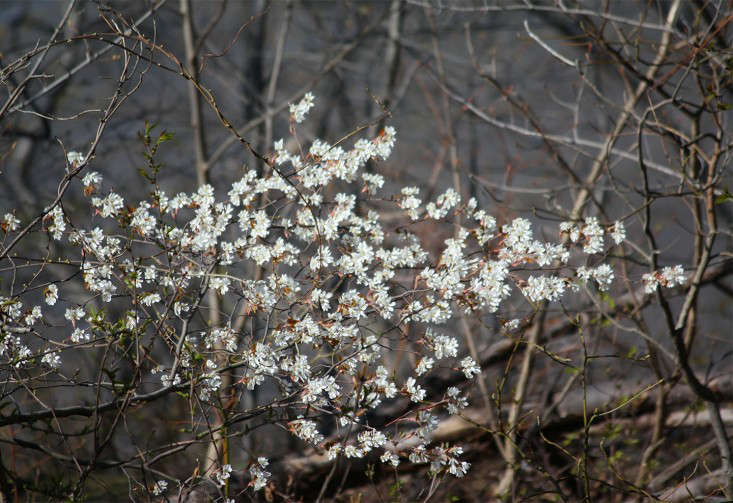Crowning a rocky ridge above the Hudson River, Inwood Hill Park is home to the last natural forest in Manhattan. The green northernmost tip of the island is easily seen from the window of a Metro-North train, whose tracks hug the southern shoreline of the mainland, before gliding north.
It is a haven for indigenous plants and some of the oldest trees in the city. And it can teach gardeners what to do with the condition that challenges so many city gardens: shade.
Photography by Marie Viljoen.
Above: Across the tidal flow of Spuyten Duyvil—the widened creek that connects the mighty Hudson with the Harlem River—is the wooded peninsula that remarkably few local residents visit. To experience this forest, you must walk into it, easily done if you catch the A train to the end of the line: 207th Street.
Above: In early spring you will see serviceberries (Amelanchier species) hugging the rocks high above the water. The indigenous tree is one of the first to bloom, and its red edible fruits are ripe in June—another common name is Juneberry. It is also known as shadbush, and in the Hudson below the forest the shad still run in spring, as they did when the Lenape lived here.
Above: To walk here is to wind around the narrow northern arrowpoint of Manhattan, high above the water, under the Henry Hudson Bridge, with rare views of the water that cuts off Manhattan from the mainland, giving small clues to what the place may have been like before we flattened and gridded it.
Above: Another early bloomer is spicebush (Lindera benzoin), also known as Appalachian allspice. This indigenous small tree’s twigs and late-summer berries are highly aromatic (resinous, and like orange zest) and can be used in cooking and baking. The youngest leaves and the flowers add bright flavor to salads.
Above: In the leaf litter under the spicebush trees Dutchman’s breeches (Dicentra cucullaria) are exquisite spring ephemerals which will have retreated into dormancy by mid-summer.
May is one of the most beautiful months in this quiet woodland. The soaring tulip poplars have leafed out, and after the thwack of ball against bat in the baseball diamonds below, the woods are a sudden silence, and empty. All you hear is the rattle of a woodpecker and birdsong. This is one of the secrets of New York City
Above: In the dappled dry shade of tall trees, invasive greater celandine (Chelidonium majus) congregates. Break a leaf and its ooze a brilliant yellow sap. Plant North American wood poppy (Stylophorum diphyllym), instead
Above: In New York, May belongs to the columbines.
Above: Aquilegia canadensis brightens the high shade of the forest floor.
Above: Solomon’s seal (Polygonatum biflorum) flowers keep local pollinators happy. One of the better-known indigenous perennials, a stand of Solomon’s seal is an ideal choice in a shaded garden, needing no extra care once established.
Above: Nearby, the buds of lookalike false Solomon’ seal (Maianthemum racemosum) have formed, demonstrating the ideal of planting for a succession of blooms in our gardens: plant perennials whose flowers open in a season-long relay. Later the fluffy white panicles open and give way to iridescent clusters of berries in late summer.
Above: And there are shrubs, too, for gardeners who want the double reward of flowers as well as edible fruit. Aronia’s pretty spring blossoms will turn to tart red or black fruit by the end of summer, very high in antioxidants and sought-after as a dietary supplement in pill form.
Above: On a steep and barren slope where nothing else wants to grow wiry blueberry (Vaccinium corymbosum) shrubs are in sea-green bloom, forming a high ground cover above mossy rocks.
Charge your subway card, pack a picnic, and head for the woods. They will not disappoint you.

























Have a Question or Comment About This Post?
Join the conversation (5)